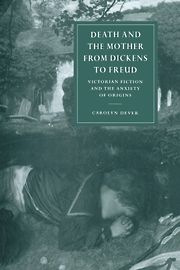Book contents
- Frontmatter
- Contents
- Preface
- 1 The lady vanishes
- 2 Psychoanalytic cannibalism
- 3 Broken mirror, broken words: Bleak House
- 4 Wilkie Collins and the secret of the mother's plot
- 5 Denial, displacement, Deronda
- 6 Calling Dr. Darwin
- 7 Virginia Woolf's “Victorian novel”
- Notes
- Index
- CAMBRIDGE STUDIES IN NINETEENTH-CENTURY LITERATURE AND CULTURE
5 - Denial, displacement, Deronda
Published online by Cambridge University Press: 09 November 2009
- Frontmatter
- Contents
- Preface
- 1 The lady vanishes
- 2 Psychoanalytic cannibalism
- 3 Broken mirror, broken words: Bleak House
- 4 Wilkie Collins and the secret of the mother's plot
- 5 Denial, displacement, Deronda
- 6 Calling Dr. Darwin
- 7 Virginia Woolf's “Victorian novel”
- Notes
- Index
- CAMBRIDGE STUDIES IN NINETEENTH-CENTURY LITERATURE AND CULTURE
Summary
Early in George Eliot's Daniel Deronda (1876), the narrator describes a scene from Daniel's adolescence:
Deronda's circumstances, indeed, had been exceptional. One moment had been burnt into his life as its chief epoch – a moment full of July sunshine and large pink roses shedding their last petals on a grassy court enclosed on three sides by a Gothic cloister. Imagine him in such a scene: a boy of thirteen, stretched prone on the grass where it was in shadow, his curly head propped on his arms over a book, while his tutor, also reading, sat on a camp-stool under shelter.
In a scene of barely repressed decadence worthy of Oscar Wilde, a pubescent boy sprawls on a bed of dead rose-petals in a defunct Gothic cloister. Still the innocent in his bed of flowers, Daniel asks his tutor a question, the answer to which represents his intellectual defloration: “‘Mr. Fraser, how was it that popes and cardinals always had so many nephews?” The reply gives Daniel his first lesson in the euphemisms that politely disguise both sexual and religious transgressions: “‘It was just for the propriety of the thing; because, as you know very well, priests don't marry, and the children were illegitimate” (203).
In her location of this scene within the architectural frame of a Gothic cloister, George Eliot foregrounds a structure that subtends the novel as a whole, for Daniel Deronda depends not only on the conventions of Gothic architecture, but also on those of Gothic fiction for its indictment of social and moral hypocrisy and its psychodramatic tension.
- Type
- Chapter
- Information
- Death and the Mother from Dickens to FreudVictorian Fiction and the Anxiety of Origins, pp. 143 - 178Publisher: Cambridge University PressPrint publication year: 1998

